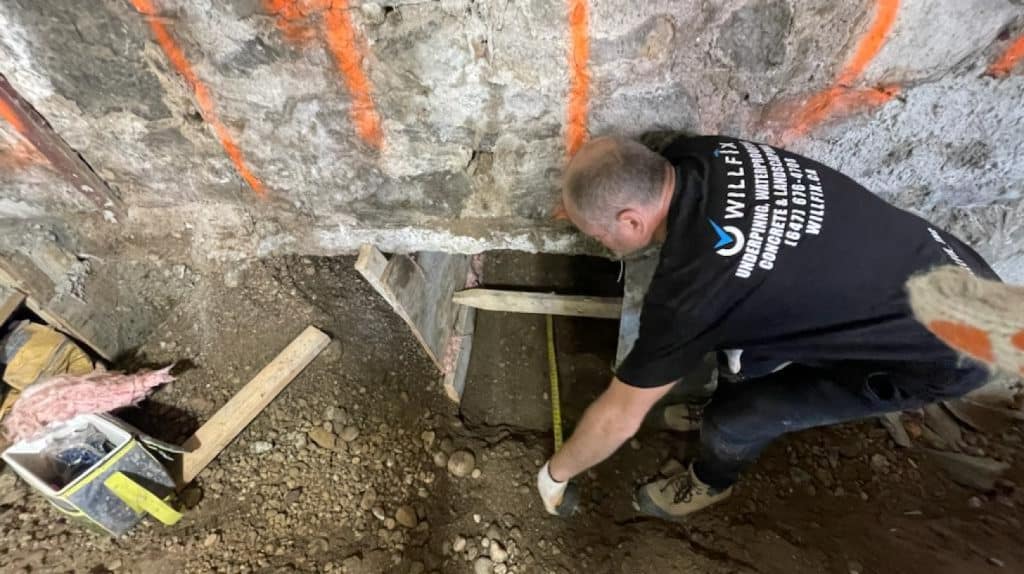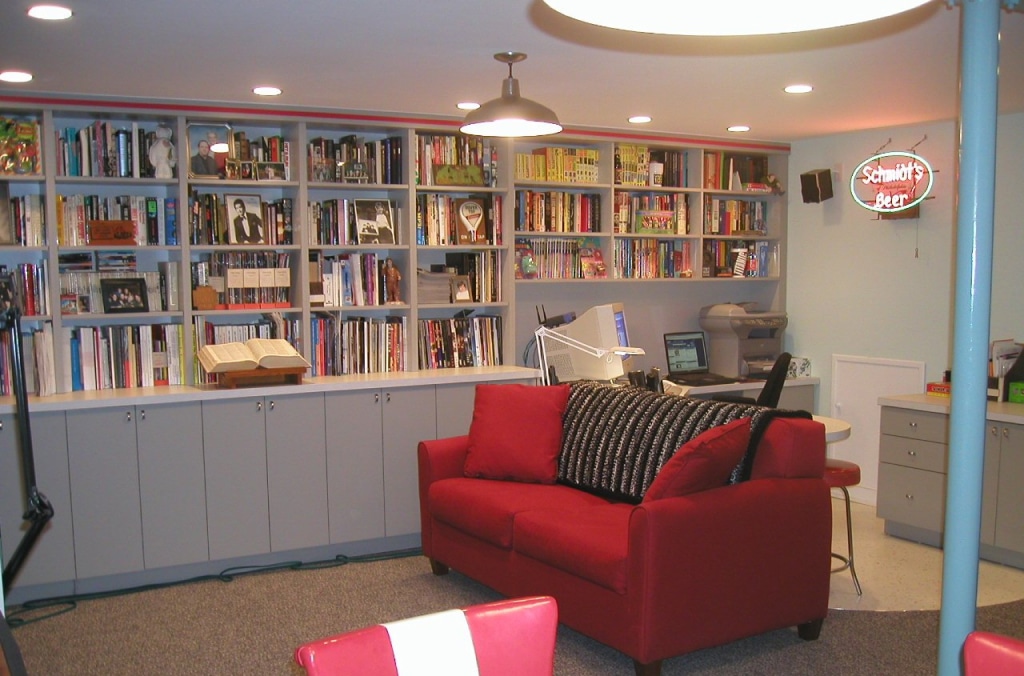Contents
Basement underpinning in Hamilton is a strategic solution to maximize the potential of the space below your main living areas. With that said, it is no wonder you want to know more about the reasons for underpinning and the basement underpinning cost breakdown.
WillFix offers transparent and affordable pricing on waterproofing and underpinning, making it easier for you to budget and plan home renovation projects.
The Concept of Basement Underpinning
At its core, basement underpinning is about reinforcing and deepening a basement’s foundation. Such a simple, at-first-sight technique has numerous benefits. It adds more room (that you can turn later into a game room, cinema, gym or whatever you want) and also fixes existing structural issues if there were any. Proper basement underpinning is your home’s sturdy foundation that will endure any earth shake, hurricane and flood.

A Brief Historical Insight on Basement Underpinning
Basement underpinning, while it is a worldwide practice, has a unique history in Canada. Many factors, including the country’s climatic conditions, architectural trends, and urban development, influenced it along the way.
- In the settler era, early Canadian settlers primarily built single-story, ground-level dwellings. However, as they became more established, there was a need to maximize space without expanding outward. Basements, initially used for cold storage, began to see foundational fortifications similar to underpinning;
- Urban growth in the 19th century — with cities like Toronto and Montreal burgeoning, the demand for residential and commercial spaces surged. Limited by city grids, architects and builders looked downward. Underpinning became more common to ensure these deeper basements were structurally sound;
- Post-WWII development — after the war, there was an immense push for housing. Basements were no longer an afterthought; they became integral parts of homes. This era saw more widespread adoption of formalized underpinning techniques to accommodate fully-finished basements;
- Modern times — today, with the escalating real estate prices and the premium on urban space, homeowners all over Canada are improving their basements. WillFix basement underpinning in Toronto combines a long underpinning history while also offering cutting-edge solutions. The WillFix basement waterproofing contractor underpinning provides additional living space and addresses challenges posed by Canada’s frosty winters, ensuring structural integrity against freeze-thaw cycles.
Canadian underpinning techniques, molded by both history and necessity, are a testament to the nation’s commitment to architectural durability and innovation.
So, why underpin a basement in Canada?
As we reflect on the rich history of Canadian basement underpinning, it’s evident that the nation’s journey wasn’t just about adapting a technique but refining and perfecting it based on unique Canadian challenges.
The cold, relentless winters, the urbanization drive, and Canadians’ evolving lifestyle preferences have all played pivotal roles.
In essence, Canada’s history of underpinning is more than a tale of construction; it’s a narrative of resilience, foresight, and evolution. Embracing these foundational techniques showcases not just a dedication to preserving history but also a vision for future growth and sustainability.
As homeowners today consider underpinning their basements, they’re not just making a personal investment; they’re becoming part of a long-standing Canadian tradition of embracing change while building on a solid foundation.
Foundations of Transformation | Top Reasons for Underpinning
As you continually seek ways to enhance your home’s value and functionality, basement underpinning emerges as a profitable solution. But if everything were based only on such motivation, the real estate market would not have gone far.
#1. Living space increase
One of the main reasons for underpinning is that basement underpinning transforms a previously forgotten area into a functional living space.
This renovation covers several needs:
- A home office;
- A dedicated playroom for children;
- A stylish home bar;
- An expansive guest suite.
You can turn your basement into any additional room you like. What’s more, you can build a walkout basement with an additional entrance and rent it out to earn extra income.

#2. Home value boost
A home with an underpinned basement often fetches a higher market price. It’s a coveted feature, signalling both space maximization and structural soundness.
#3. Structural safety reinforcement
Reinforcing a home’s foundation means enhanced safety. Underpinning guarantees a more stable and resilient structure, which is particularly vital in regions prone to seismic activity, flooding, or ground shifts.
#4. Moisture and pest disappearance
Moisture and pests are among the top reasons for underpinning. A well-underpinned basement prevents these issues from arising, safeguarding the integrity of the house and the health of its inhabitants.
#5. Energy efficiency improvement
Improved insulation is a direct benefit of underpinning. You will significantly reduce energy bills, as proper basement underpinning prevents thermal leaks and maintains indoor temperature consistency.
Factors Determining Basement Underpinning Costs
As with any home renovation project, basement underpinning requires thoughtful budgeting. Various factors impact the overall cost. Our cost breakdown will help you make informed financial decisions that ensure your investment will be profitable.
- Square footage — simply put, the larger the basement, the more materials and labour required;
- Depth adjustments — going deeper means additional costs due to more excavation, material usage, and potential complications;
- Layout complexity — a basement with many partitions or rooms demands more complicated work;
- Material choices — opting for high-grade materials like steel or specific types of concrete influences costs;
- Labour expertise — the proficiency and experience of the contractors affect both the quality and cost of the job;
- Custom storage solutions — think wine cellars, built-in bookcases, or hidden storage units. These custom solutions, while enhancing usability, can bump up the budget;
- Lighting — while basic lighting might suffice for some, others might envision ambient or smart lighting solutions, which come with additional expenses.
By keeping these factors in mind and collaborating with trusted professionals, you will be able to strike the right balance between budget and quality, ensuring your renovated basement stands the test of time.
Conclusion
There are various practical reasons for underpinning. Basement underpinning is more than a luxury. It actively represents a forward-thinking, strategic approach to modern home improvement.
Basement underpinning is a transformative process that transforms an overlooked space into an integral part of the home.
By investing in this renovation, you are also investing in your future, ensuring your residence is both functional and attractive for potential buyers.
Reasons for Underpinning FAQ
-
When should I start basement underpinning if I decide that I want it?
WillFix performs basement reinforcement all year round. However, some seasons are preferable: summer and early autumn. We should consider many factors before starting the excavation, so it would be best to contact us beforehand for a free consultation!
-
What is the main reason for basement underpinning?
It's simple: with basement underpinning, you'll get an extra, absolutely safe, waterproof room that you can further transform into a rentable unit or a cozy home cinema. Long story short, with proper basement lowering and underpinning, your home transformation possibilities are endless.
-
Why basement underpinning is popular?
It is no news that real estate prices are growing by leaps and bounds. While new families want to live separately from their parents, even renting a condo can be pricey. That's why there's a growing demand for small rentable spaces to live in, such as underpinned or walkout basements. As a homeowner renting a basement, you'll get additional income and better structural stability because all potential issues will be addressed during the building stage.

